MHR
MANUFACTURED HOUSING REVIEW
News and educational articles to help you run your business in the manufactured home industry.
IN THIS ISSUE:
INTRODUCING the Manufactured Community Owners Association of AmericaAnEnthusiasticIndustryAdvocate
Significant Events Occurring Throughout the Manufactured Housing Industry

Five Reasons Why Mobile Home Park Investing is Recession and Inflation Resistant ... and much more!

Sponsored by:

2022 | Quarter 1
Mark Weiss
By Brian S. Wesbury, Robert Stein, Strider Elass, Andrew Opdyke
Yoel
By David Jones and Bryan Pope
By Ellen Savage
By D. Austin Lewis
Table of Contents Where is the ‘Equity’ for Manufactured Homes and Consumers of Affordable Housing? . . . 5 By
First Trust - Liftoff in March . . . . . . . . . . . . . . . . . . . . . . . . . . . . . . . . . . . . . . 8
The Alabama Manufactured Housing Association Leads the Way with New Legal Help Assistance for Members . . . . . . . . . . . . . . . . . . . . . . . . . . . . . . . . . 10 By Alabama Manufactured Housing Association Significant Events Occurring Throughout the Manufactured Housing Industry . . . . . . . . 11 By George Allen Can “Mission Driven” Mobile Home Park Investors Raise Rents to Market and Evict Problem Residents? . . . . . . . . . . . . . . . . . . . . . . . . . . . . . . . . . . . . 13
Revisiting John Oliver’s Insulting and Juvenile Take on the Mobile Home Industry . . . . . 16 By Benjamin Ivry Texas Housing Manufacturers Prepare for Sales Surge Despite Ongoing Supply- Chain Disruptions . . . . . . . . . . . . . . . . . . . . . . . . . . . . . . . . . . . . . . 18
Attend Congress & Expo in Orlando in April . . . . . . . . . . . . . . . . . . . . . . . . . . . 19
Investing Outlook for 2022 . . . . . . . . . . . . . . . . . . . . . . . . . . . . . . . . . . . . . . 21
How an Assistant Professor in Colorado Apparently Caused the Entire Media Uproar Against Mobile Home Park Owners for the Last Several Years . . . . . . . . . . . . . 25
Five Reasons Why Mobile Home Park Investing is Recession and Inflation Resistant . . . . 28
Keel How to Put Together a Great Loan Package for Lenders That Will Get Approved . . . . . . 34 By
Porter 58% IRR: A Mobile Home Park Opportunity Zone Case Study . . . . . . . . . . . . . . . . . 39
Kelman
By Daniel Weisfield and
Kelman
By Benjamin Ivry
By Andrew
Gregory J.
By Daniel Weisfield and Yoel
Announcing!
The manufactured home community industry is finally garnering the respect it has always deserved –except in one key area: there are limited industry Rebuttals to an endless sea of negative narratives in the media and city, state and federal government. The concept of “turn the other cheek” sounds good, but the reality is that it just gets you struck on the other side of your face.
MHC owners have had to suffer through a hostile political landscape long enough without any opposing views being expressed. How many disgusting articles have we all read or watched –from John Oliver to the New Yorker –yet the industry remains silent? And how many more will come our way from our lack energy in this regard?
In an attempt tofill this simple but important void, the Manufactured Community Owners’ Association of America (MCOAA) has been formed. Our mission is simple:

Effective immediately, we will fight back against any negative article, speech, or newscast by publishing opposing viewpoints and working to link these with conservative publications that appreciate the role of business and are not afraid to point out the anti‐affordable housing crowd in most American media.
But how can we accomplish this? How can we actually battleMHActionand publications that support the concept that landlords are evil, and that capitalism is a sin? Here’s our plan:
As soon as any negative piece on the mobile home park industry is identified, we will immediately call on a number ofprominent industry professionals to write articles or produce videos that offer the opposing viewpoint.
We will use every available technique to then get these counterpoints to the top of Google through search engine optimization. The goal will be for our articles to rank just as high –or higher –than the negative piece.

Meanwhile, we will be working hard with outreach to pro‐business publications to produce positive media reviews of our important niche within the affordable housing industry.
We are also pleased to announce that we have purchased the domain MHAction.com, andwill be providing counterpoints to all oftheir initiatives on this website, so that a fair and balanced opinion can be found on what is currently an unreasonable and non‐productive narrative.
Effective with our next issue, the Manufactured Housing Review magazine will become the official publication of the MCOAA.
So, what can you do to support this effort? It will cost money to enact this agenda –not much but a little. We have priced our memberships at $120 per year. We are hoping to initially get 100 mobile home park owners to join, which will generate around $1,000 per month in revenue, all of which will be used to promote our media agenda. As our membership grows, we will simply ramp up our media blitz efforts.
Benjamin Ivry, the voice of MCOAA staff@manufacturedhousingreview.com
Benjamin Ivry, the voice of MCOAA
THE MANUFACTURED COMMUNITY OWNERS’ ASSOCIATION OF AMERICA

Finally Bringing Fight to the Manufactured Home Community Sector of the Industry
So, what can you do to support this effort? It will cost money to enact this agenda –not much but a little. We have priced our memberships at $120 per year. We are hoping to initially get 100 mobile home park owners to join, which will generate around $1,000 per month in revenue, all of which will be used to promote our media agenda. As our membership grows, we will simply ramp up our media blitz efforts.
Park Owner Name:
Corporate Name:

Email:
Facebook:
Website:
Phone:
Comments:
Can we use your comments in our articles? YesNo
Please send your support via PayPal to Staff@Manufacturedhousingreview.com
Support MCOAA
Where is the ‘Equity’ for Manufactured Homes and Consumers of Affordable Housing?
The Biden Administration, this month, marks its first full year in office. As one of his initial steps, President Biden announced that the concept of “equity” – economic equity and, most especially, racial equity – would be a bedrock foundation for his Administration’s policies and programs. In an Executive Order issued on January 20, 2021, “equity” is defined as “the consistent and systematic fair, just and impartial treatment of all individuals, including individuals who belong to underserved communities that have been denied such treatment … persons who live in rural areas; and persons otherwise adversely affected by persistent poverty or inequality.” (Emphasis added). That such “equity” principles, under the Biden Administration, can and do apply to all aspects of housing, is made clear by a follow-up presidential memorandum issued just days later.

That document states, in part: “racial inequality still permeates land-use patterns … and virtually all aspects of the housing markets.” (Emphasis added). As a result, the memorandum directs federal agencies to “eliminate racial bias and other forms of discrimination in all stages of home-buying and renting … and secure equal access to housing opportunity for all.” (Emphasis added).
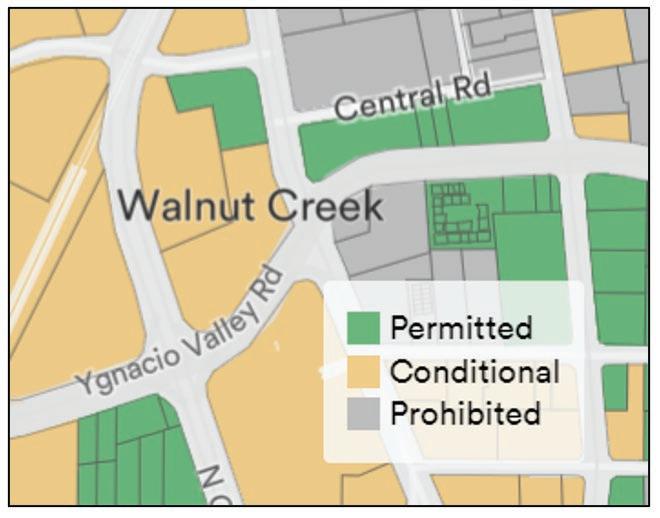
A key issue for the HUD Code industry following a full year of the Biden Administration, then, is where do manufactured homes and manufactured housing consumers stand with respect to the concept of “equity” and the application of “equity” principles? The short and unacceptable answer (for now), is “nowhere.” Sadly, and despite two outstanding laws that should have ended structural discrimination against manufactured homes, manufactured homebuyers and manufactured homeowners years ago, the Administration’s “equity” policies have yet to be applied by federal agencies and Biden Administration officials within the manufactured housing market. The result is not only an absence of “equity” for those affected, but a continuing severe shortage in the supply and availability of affordable housing and, more specifically, affordable manufactured housing, accessible to Americans of “all” races at “all” income levels, in direct violation of President Biden’s stated policies and objectives.
By Mark Weiss
How and where, then, do equity principles need to be applied to benefit Americans seeking (and needing) access to affordable manufactured housing that is comprehensively regulated by the federal government? As industry members and consumers of affordable housing are all too aware, despite modest signs of recovery, the manufactured housing market has been suppressed far below historic production levels for well over a decade and continues to lag behind the broader single-family housing market. As MHARR has repeatedly emphasized, the primary reasons for this utilization and growth gap between manufactured housing and other types of single-family housing, are both rooted in the continuing failure of the industry’s post-production sector. Those factors, as confirmed by a 2018 Urban Institute study authored by former HUD Principal Deputy Assistant Secretary Edward Golding and newly-installed Ginnie Mae President Alanna McCargo, are: (1) continuing and ongoing discrimination against manufactured housing consumers at the federal level with respect to home purchase financing; and (2) continuing and ongoing discrimination against manufactured housing homeowners with respect to zoning and home placement
Interestingly, the conclusions of these housing experts -- Mr. Golding and Ms. McCargo -- correspond with, and (again) confirm, initial MHARR research and analysis for its upcoming White Paper seeking answers and solutions relating to the exploitation of federal housing funding and assistance for purely public relations purposes by ostensible representatives of the industry’s post-production sector. This White Paper will provide long-needed answers as to why so many federal housing programs which nominally include HUD Code manufactured housing by name, are rarely if ever funded
- 5 -
and used to support and promote manufactured housing in the field. More on this, though, when the final White Paper is completed and published soon.
For present purposes, the factors cited by Mr. Golding and Ms. McCargo – actually, policy failures – have worked to exclude millions of lower and moderate-income Americans, including large minority populations, from not only the manufactured housing market, but from homeownership altogether, as mainstream manufactured housing continues to be the nation’s most affordable source of non-subsidized housing and home ownership. And while both of these matters fall squarely within the scope of President Biden’s “equity” agenda pertaining to housing, there has been, thus far, no meaningful improvement regarding either at the federal level.
Focusing first on the application of equity principles within the manufactured home consumer financing market (zoning discrimination and equity will be addressed in a future column as well as in MHARR’s detailed White Paper), the failure to infuse equity considerations and policies within the implementation of the Duty to Serve Underserved Markets (DTS) mandate is a major policy failure that continues to harm minorities and lower-income populations within the manufactured housing market, as confirmed by the most recent data and analysis published by the Consumer Financial Protection Bureau (CFPB).
rates than are charged today. This, in itself, would result in a greater number of qualified and approved borrowers, a larger number of manufactured home loans actually made, and a greater number of manufactured homes sold and available to address the nation’s affordable housing crisis.
Conversely, in the absence of DTS-based market-significant securitization and secondary market support for manufactured housing consumer loans – and the absence of any DTS support whatsoever for the personal property loans that comprise nearly 80% of the manufactured housing purchase financing market – manufactured homebuyers in general and minoritygroup manufactured homebuyers in particular, are harmed in multiple ways as corroborated by CFPB data and analysis.
• First, the absence of broad securitization and secondary market support within the manufactured home consumer lending sector needlessly limits the number of lenders operating within that sector, rendering the entire sector less competitive with respect to interest rates than would be the case in a fully-competitive market.
This is confirmed by a May 2021 CFPB report specifically documenting the concentration of manufactured home consumer lending within a very small number of marketdominant lenders. The report thus notes that the two most dominant manufactured housing lenders, “21st Mortgage and Vanderbilt [Mortgage Corporation] … both subsidiaries of Clayton Homes,” control a “combined 30 percent of the manufactured housing market, including 56 percent of chattel lending….” (Emphasis added).
• Second, higher-than-necessary interest rates for manufactured home purchase loans in the absence of DTS support and a less-than-fully-competitive lending market, particularly within the personal property/chattel sector, needlessly exclude significant numbers of borrowers who might otherwise qualify for purchase financing if interest rates and corresponding monthly payments were lower.
DTS, of course, directs Fannie Mae and Freddie Mac to provide securitization and a secondary market support for certain historically underserved markets, including HUD Code manufactured housing and the personal property/chattel loans which finance the vast bulk of manufactured housing purchases. If fully implemented on a market-significant basis, DTS would result in lower interest rates on manufactured home consumer loans. By securitizing and providing a secondary market for those loans, Fannie Mae and Freddie Mac would lower the degree of risk borne by loan originators and holders, and simultaneously draw new lenders into the manufactured housing consumer finance market. Lower risk coupled with increased competition would invariably lead to lower interest
This is again confirmed by the May 2021 CFPB report, which shows that only a small “minority (27 percent) of consumers who applied for a loan to buy a manufactured home succeeded in obtaining financing.” By contrast, “an estimated 42 percent of all manufactured home purchase applications were denied, including 50 percent of chattel applications….” (Emphasis added). This compares with a denial rate of “only 7 percent” for site-built home purchase loan applications.
• Third, such market exclusion and higher interest rates, particularly for HUD Code personal property loans, disproportionately impact and harm minority purchasers

- 6 -
Where is the ‘Equity’ for Manufactured Homes and Consumers of Affordable Housing? Cont.
The May 2021 CFPB report specifically states that: “Hispanic white, Black and African American, and American Indian and Alaska Native borrowers make up larger shares of chattel loan borrowers than … among site-built loan borrowers” and that “Black and African American borrowers are … overrepresented in chattel lending….” Combining this with the other datapoints and conclusions noted above, the CFPB analysis proves that African Americans and other minorities, under existing Fannie Mae and Freddie Mac policies concerning the implementation of DTS (as approved thus far by the Federal Housing Finance Agency-FHFA), are – and continue to be -- disproportionately harmed.
Nor is this harm confined to the policies of FHFA, Fannie Mae and Freddie Mac with regard to private loans. In addition to DTS, federal law – i.e., the Title I Federal Housing Administration (FHA) manufactured home loan program -- mandates federal government support for manufactured home personal property loans. Years ago, this program supported the origination of tens-of-thousands of manufactured home purchase loans – securitized by the Government National Mortgage Association (Ginnie Mae) – annually. In 2010, though, Ginnie Mae adopted its egregious “10-10” rule regarding qualifications for Title I lenders, and the bottom fell out of Title I originations which, today, are virtually nonexistent. Effectively, then, there is no federal government support for manufactured home lending – either public or private – leaving potential homebuyers with virtually nowhere to go except the market-dominant higher-rate lenders, if they can qualify for any loan at all.
Ultimately, then, the failure of FHFA, Fannie Mae and Freddie Mac to implement DTS with respect to manufactured housing chattel loans, together with the parallel failure of FHA and Ginnie Mae to fully implement the Title I manufactured housing program, has allowed an economically-distorted, less-thanfully-competitive, systemically-discriminatory structure within the manufactured housing personal property lending market -- with identifiable and quantifiable adverse impacts on racial minorities and other disadvantaged Americans -- to remain in place, with no real effort, thus far, from the Biden Administration (assuming it is even aware of these issues due to the ongoing deficient representation of the post-production sector in Washington, D.C.) to remedy that failure through the application of equity principles and concepts.
There may be reason for hope going forward, given the recent elevation of Sandra Thompson and Alanna McCargo
to serve as the Director of FHFA and President of Ginnie Mae respectively. MHARR has had – and continues to have -- a positive dialogue with Ms. Thompson regarding the need for chattel loan DTS support. When Ms. Thompson served as FHFA Assistant Director, she spent a significant time meeting with MHARR and MHARR member manufacturers to understand the damage to the industry and consumers resulting from Fannie Mae and Freddie Mac’s failure to provide robust, market significant securitization and secondary market support under DTS for manufactured home consumer loans. And, as previously noted, Ms. McCargo is on record as acknowledging the destructive impact of financing discrimination on the availability of affordable, non-subsidized manufactured housing. Perhaps such leaders, with specific previous knowledge of the manufactured housing industry and effective pressure from the industry, can produce real change.


As the old saying goes, however, “hope” is not a strategy. The industry faces serious challenges within its postproduction sector. Nothing will change, though, unless and until the industry decides that it is serious about change –and that ultimately means aggressive, independent national representation for the post-production sector in Washington, D.C. in order to correct these (and other) deficiencies that have harmed both the industry and American consumers of affordable housing.
Mark Weiss is the President and CEO of the Manufactured Housing Association for Regulatory Reform (MHARR) in Washington, D.C. He has served in that position since January 2015 and, prior to that, served as MHARR’s Senior Vice President and General Counsel.

MHARR is a Washington, D.C.-based national trade association representing the views and interests of independent producers of federally-regulated manufactured housing.

- 7 -
Where is the ‘Equity’ for Manufactured Homes and Consumers of Affordable Housing? Cont.
Liftoff in March
The Fed stayed the course today, with no change in the Fed Funds rate, no adjustment to the pace of tapering, no shift in the timeline for raising rates, and no indication that they intend to lift rates in larger steps.
Barring a sharp change in the economic outlook, the Fed looks virtually certain to raise the Fed Funds rate by 25 basis points at the March meeting. When pushed during the press conference, Chair Powell was very intentional not to commit to a pace of hikes as the year progresses. We could see hikes at every meeting or every other meeting, only time (and the data) will tell.
Text of the Federal Reserve's Statement:

Indicators of economic activity and employment have continued to strengthen. The sectors most adversely affected by the pandemic have improved in recent months but are being affected by the recent sharp rise in COVID-19 cases Job gains have been solid in recent months, and the unemployment rate has declined substantially. Supply and demand imbalances related to the pandemic and the reopening of the economy have continued to contribute to elevated levels of inflation. Overall financial conditions remain accommodative, in part reflecting policy measures to support the economy and the flow of credit to U.S. households and businesses.
The path of the economy continues to depend on the course of the virus. Progress on vaccinations and an easing of supply constraints are expected to support continued gains in economic activity and employment as well as a reduction in inflation Risks to the economic outlook remain, including from new variants of the virus.

One area where we did get some clarification from the Fed came with regards to the balance sheet. In addition to confirming that tapering will conclude in early March, the Fed published guidance on the path towards reducing the size of the balance sheet. Some have questioned if the normalization process would start in March along with rate hikes, but today's announcement shows the Committee expects to wait until after rate hikes are under way. It was also notable that there was no indication that the Fed is considering the outright sale of assets. Instead, guidance mimicked reductions coming through the management of monthly reinvestments as occurred back in 2017.
The Fed is behind the curve on fighting inflation, tapering should already be over, and rate hikes should already have begun. The risk today is that the Fed moves too slowly, not too quickly. Inflation is likely to remain stubbornly high throughout 2022 and beyond, and the biggest question today is how long it takes for the Fed to step up to the challenge.
Brian S. Wesbury, Chief Economist Robert Stein, Deputy ChiefEconomist
The Committee seeks to achieve maximum employment and inflation at the rate of 2 percent over the longer run In support of these goals, the Committee decided to keep the target range for the federal funds rate at O to 1/4 percent. With inflation well above 2 percent and a strong labor market, the Committee expects it will soon be appropriate to raise the target range for the federal funds rate The Committee decided to continue to reduce the monthly pace of its net asset purchases, bringing them to an end in early March. Beginning in February, the Committee will increase its holdings of Treasury securities by at least $20 billion per month and of agency mortgage-backed securities by at least $10 billion per month. The Federal Reserve's ongoing purchases and holdings of securities will continue to foster smooth market functioning and accommodative financial conditions, thereby supporting the flow of credit to households and businesses.
In assessing the appropriate stance of monetary policy, the Committee will continue to monitor the implications of incoming information for the economic outlook. The Committee would be prepared to adjust the stance of monetary policy as appropriate if risks emerge that could impede the attainment of the Committee's goals The Committee's assessments will take into account a wide range of information, including readings on public health, labor market conditions, inflation pressures and inflation expectations, andfinancial and international developments
Voting for the monetary policy action were Jerome H Powell, Chair; John C. Williams, Vice Chair; Michelle W. Bowman; Lael Brainard; James Bullard; Esther L George; Patrick Harker; Loretta J. Mester; and Christopher J. Waller. Patrick Harker voted as an alternate member at this meeting.
□
ECONOMIC
First Trust
RESEARCH REPORT
Brian S. Wesbury - Chief Economist
Robert Stein, CFA - Dep. Chief Economist
Strider Elass - Senior Economist
�anuary 26tli, 2022 • 630.517.7756 • www.ft ortfolios.com
Andrew Opdyke, CFA - Senior Economist
Fed Funds Target Rate % 4 50�----------------7-4 50 3 75 3 75 3.00 3 00
Source: Federal Reserve Board/Haver Anatyb::s
Experienced. Reliable. Innovative. Nationwide.

Sunstone Real Estate Advisors is the nation’s largest independent advisory firm focused exclusively on the manufactured housing and recreational vehicle asset class. At our core, we believe in upholding the lost art of real estate transactions through our values – accuracy, diligence, integrity, reliability and trust. Our clients realize the benefit of our vast relationship network and nationwide industry expertise.

OFFICES
CHICAGO 650 N Dearborn, Ste 850 Chicago, IL 60654
P: 312-888-3903
DALLAS 4000 W University Denton, TX 76207
P: 972-992-0047
HOUSTON 240 Bolivar Anahuac, TX 77514
P: 832-741-2178
CHARLESTON
1150 Hungryneck Blvd Charleston, SC 29464
P: 865-809-7328
MHC
Sunstone provides expert consulting services and nationwide brokerage solutions for the MHC and recreational vehicle asset class.


For more information, visit sunstonerea.com

BROKERAGE 1.7B+ in sales encompassing over 64,000 spaces
70+ Years
in the
asset class CAPITAL 45 STATES advisory and service firm
CONSULTING
experience
The Alabama Manufactured Housing Association Leads the Way with New Legal Help Assistance for Members

Alabama Manufactured Housing Association members seeking assistance will be placed in contact with AMHA’s general counsel, Sasser, Sefton & Brown, P.C. Any consultation and necessary follow-up will be limited to a two-hour block of time yearly per member.
The purpose of the help desk is to provide general legal information and advice and there is no obligation for AMHA or its general counsel to provide any advice beyond the limited consultation.

All current members of AMHA are eligible to utilize this help desk.
Are there any issues that are not covered?
The purpose of the program is to provide free, limited advice for the member’s business. As a result, the help desk is not intended to provide advice on the personal legal issues of any officer or employee of the member. Additionally, the help desk
By Alabama Manufactured Housing
Association
may not be utilized in the event a member wishes to take an adverse position to another member or AMHA. If the issue will require retention of an attorney outside the limited general consultation paid for by AMHA, you can discuss retention of Sasser, Sefton & Brown or other counsel of your choosing on terms agreed to by you.
What do I need to do to request this benefit?
Call the Sasser, Sefton & Brown firm at (334) 532-6140. You will be connected with a legal assistant who will get your contact information and send you a form to sign prior to your legal consultation. You will then be connected to an attorney.



- 10 -
Significant Events Occurring Throughout the Manufactured Housing Industry

While we’re buried in an ongoing snowfall here in the Midwest (Everything is closed today!), I’m heartened to see some of my ‘friends in the MHBusiness’ assuming leadership roles throughout the industry and realty asset class. More about that in a moment.
First, some pretty darn heady news for you! It’s official; as of receipt of the IBTS monthly report of new HUD-Code homes shipped during December 2022, as an industry we have eclipsed to 15 year elusive 100,000 new homes shipped total! Yes, the number shipped during December 2022, according to HUDs official record keeper, was 8,014, and with NO Destination Pending units for anyone to use to suggest a different total. And when the 8,014 units are added to the totals for the previous 11 months, the grand total, is 105,772. Yes, 105,772 - and don’t let anyone tell you differently. These monthly and YTD totals are based wholly on Institute of Building Safety & Technology reports - no more, no less!
MH Shipment Volume for December 2021 & MH Stock Market Report
Institute for Building Technology & Safety (‘IBTS’) reports
8,014 HUD-Code homes shipped.*1
By George Allen
Compare to Dec.2020 = 7,633 homes; & 9,069 MHs during Nov. 2021. 12,638 floors shipped*2
YTD MHShipments @ Dec.2021 = 105,772 units. Compared to Dec. 2020 YTD total of 94,390 new HUD-Code homes. Read GFA’s weekly blog via www.educatemhc.com to stay informed!
Dr. Stephen C. Cooke’s ‘production value’ of new HUD-Code homes? $43,126/home X 8,014 shipped = $451 million. Total 2021 U.S. economic impact YTD? 105,772 units = $4.56 billion
Public Market Side of Manufactured Housing
BRK-A. Berkshire Hathaway, Inc. includes Clayton Homes. News: Up from $453K in January. Most recent stock price: $476K
SKY. Skyline Champion Corporation
News: Down from $77.56 in January. ‘4th Qtr earnings @ 51.28% & revenue @ 6.59%’ Most recent stock price: $73.95
CVCO. Cavco Industries, Inc.
News: Down from $312.43 in January. Most recent stock price: $292.00
- 11 -
Significant Events Occurring Throughout the Manufactured Housing Industry Cont.
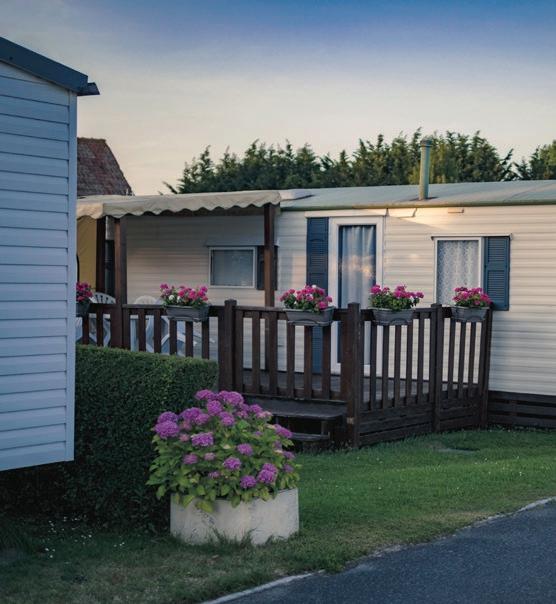
LEGH. Legacy Housing Corporation
News: Down from $25.94 in January.
Most recent stock price: $25.51
Nobility Homes. (‘NOBH’)
News: Down from $33.10 in January.
Most recent stock price: $32.10
Land Lease Community Portfolio Investing
ELS, Inc. Equity Lifestyle (#1 @ 32nd ALLEN REPORT*3)
Most recent stock price: $78.43
News: Down from $84.75 in January. ‘21% Return on Equity per ELS’
SUI. Sun Communities, Inc. (#2 @ 32nd ALLEN REPORT)
Most recent stock price: $193.36
News: Down from $206.24 in January.
UMH. UMH Properties, Inc. (#6 @ 32nd ALLEN REPORT)
Most recent stock price: $24.02
News: Down from $26.66 in January. ‘Stock up 4.5% in 2021’ (until 2/2/22)
Flagship Communities @ TSC (#23 @ 32nd ALLEN REPORT)
Most recent stock price? $18.50
News: Down from $19.30 in January.*4
MHPC, Inc. Manufactured Housing Properties, Inc. (#28 @ 32nd ALLEN REPORT). Stock: $2.53
Manufactured housing/land lease community Composite Stock Index (‘CSI’) @ 3 February 2022 = $738; down from $788.87 in January. All MH stocks dropped in price except BRK-A.
ANNOUNCEMENTS. *) Per FHFA, ‘U.S. House Prices Rise 17.5
Percent during year 2021.
*) 2021 MH shipment total of 105,772 = highest since 2006 & 117,510 homes. 15 years ago!
*) Wondering how to get this ‘shipment # & stock prices’ info into your hands monthly? Let me know of your interest via gfa7156@aol.com
End Notes:
1. IBTS =HUD’s perennial contractor for tracking & reporting HUD-Code housing shipments
2. HUD, MHARR & Educate MHC always report the same monthly IBTS MH Shipment Total. MHI reduces said # by number of Destination Pending units, then adds back next month.
3. 32nd ALLEN REPORT (2021) oldest, most reliable annual survey of land lease community portfolio statistics & real estate asset class’ emerging trends: www.educatemhc.com Hint: Don’t already have a copy? Buy one today, for use now & reference in the future!
Disclaimer. This ‘# & $’ information comes from careful, albeit not perfect, research across MH industry & realty asset sector lines. Corrections and suggestions welcome!
George Allen, CPM™Emeritus, MHM™Master, Emeritus Member of the Manufactured Housing Institute (‘MHI’), & 2011 inductee into RV/MH Heritage Foundation’s prestigious Hall of Fame. Dial (317) 881-3815 to reach George Allen, CPM, MHM. You can access my weekly blog, as well as the Allen Legacy column in MHInsider magazine. Reach me via gfa7156@aol.com
- 12 -
Can “Mission Driven” Mobile Home Park Investors Raise Rents to Market and Evict Problem Residents?
We are a for-profit, mission driven company, operating 40+ mobile home parks and manufactured housing communities in 7 states. We have a two-part mission: to deliver high-value housing that our Residents are proud to call home, and to deliver compelling risk-adjusted returns to our Investors. Our core values include acting with integrity and treating all people as we would want to be treated.
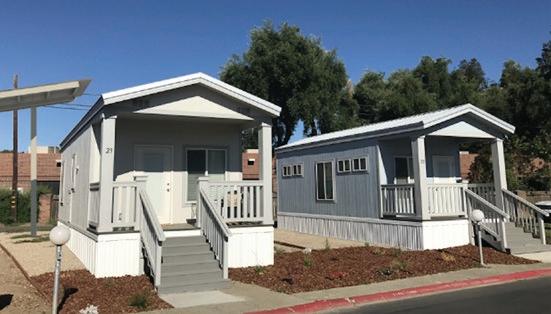
People don’t always understand what we mean by this. As a result, people sometimes perceive a tension between our operating practices and our stated values, even though they are fully aligned. So, we are writing this in order to share exactly what we mean when we talk about our social impact mission. Our Residents and our Investors should both know exactly what we mean.
In terms of our business philosophy, and our life purpose: This is how we see ourselves creating a better world, with more safety, more fairness, and more opportunity for people across the social and economic spectrum. This is how we are manifesting the world that we (Daniel and Yoel, the company’s founders) want to see. This involves our ethical beliefs. And it requires trade-offs. Not everyone will agree with our values. There is no single formula for “integrity” or “fairness” or “social impact.”
1. We provide safe and clean housing. In some communities we provide a high-end amenities package. In some communities we don’t. But we commit to provide safe and clean housing in all our communities.
2. We provide communities that are objectively affordable. The cost to live in our communities is a fraction of the cost of buying a conventional site-built home, and significantly cheaper than renting an apartment. We sometimes get
By Daniel Weisfield and Yoel Kelman
into debates about specific rent increases. But the “big picture” is that essentially all our properties provide rent prices that are affordable to low-income households earning less than 80% of area median income (AMI).
3. We provide safe and clean housing regardless of race, color, creed, social background, or sexual orientation. We use objective criteria for resident applications, and if you meet the criteria, you’re approved. That is the essence of the federal Fair Housing Act. As a deliberate social choice, we do not ask about immigration status, nor do we require applicants to have a social security number. We are proud to provide safe and clean housing for our fellow Americans, regardless of how and when they got here.
4. In order to provide safe and clean neighborhoods, we remove residents who threaten the health and safety of other residents. This should be obvious. This is our duty to our residents, and this is required by common sense. We are not embarrassed about removing people from our communities (in accordance with all applicable landlordtenant laws) if they are engaged in crime, or pose a health and safety threat, or perpetuate blight. It is patronizing and offensive to say that our residents should just have to live with these issues because they are “low income” or “live in a mobile home park.”
5. We help our residents build wealth through homeownership. Between 2014 and 2019, manufactured home values rose faster than site-built home values in 27 states. Manufactured homes appreciate the most when they are located in well-managed communities, like the communities we run. Our residents routinely build significant wealth by buying manufactured homes in our communities and then giving the market time to do its job. This is one of the most satisfying aspects of the work we do.
6. We upgrade our neighborhoods and extend the supply of affordable housing by replacing obsolete manufactured homes with new homes. Some park owners are content to just collect lot rent from existing manufactured homes (even if those homes are at the end of their useful life). We want our parks to provide clean, safe, affordable housing for another 50+ years, so we work proactively with residents to replace outdated housing stock with new, attractive, energy-efficient manufactured homes.
- 13 -
Can “Mission Driven” Mobile Home Park Investors Raise Rents Cont.
7. We believe in charging market rent. “Market rent” is the rent that local people who do not live at our property are willing to pay in order to move into the property. Our existing residents, who signed leases years ago, often have below-market rents, and we believe in raising those rents to market over time. We believe this is good for society. If mobile home park owners do not earn a fair return on their investment, they will not be able to reinvest capital into their parks in order to keep them safe, clean, and functional for residents in the long term. And if rents get “trapped” below market, then mobile home parks (which are a naturally occurring form of affordable housing) will eventually be redeveloped into other more profitable land uses.
8. We work case by case with individual residents who cannot afford rent increases. Over time, when we raise rents to market, there are sometimes existing residents who are very low-income who cannot afford a rent increase, based on their individual circumstances. So, we work with those residents! We voluntarily offer rent subsidy programs for qualified residents. We also invest time and resources to connect those residents with public assistance programs for which they are eligible. At the end of the day, the fact that a certain resident with a challenging personal circumstance cannot afford market rent does not mean that we should not charge market rent. We charge market rent, and then we work with individual hardship residents on case-by-case basis.
9. We oppose rent control. Rent control creates a class of “haves” (the people who have access to cheap housing, locked in at below-market rates) and “have nots” (everyone else).
10. We are here to listen and learn, and our views may change over time. One of our five core values is having a growth mindset. We are always open to feedback, and willing to pivot if our convictions change.
In Summary
This list of ten practices is a summary of how we manifest our personal values as manufactured housing operators. This is what we mean, specifically, when we say we act with integrity, and we treat all Residents with dignity and respect.
I think codifying these values and sharing them publicly with current and prospective Residents shows how seriously we take this mission.
We are always balancing the interests of several distinct groups: our “average” Residents (the 99% of Residents who want clean, safe neighborhoods they are proud to live in), our small handful of “challenging” Residents (who need to comply with our community standards or seek an alternative), and our thousands upon thousands of “prospective” Residents (who have very few affordable options available in the market, and who would love to live in our communities if we had more vacancies available).
We are treating people exactly as we want to be treated.
Daniel Weisfield (Co-founder) is a third-generation mobile home park investor. His grandfather immigrated to the United States, saved money by fixing cars in his backyard, and eventually bought a mobile home park. Daniel is a licensed manufactured home dealer in four states and believes manufactured housing is the best way to create affordable communities that residents are proud to call home. Daniel has a J.D. and M.B.A from Yale. He previously worked as a management consultant at McKinsey & Company. daniel@threepillarcommunities.com
Yoel Kelman (Co-founder) is a manufactured housing finance and operations expert. His grandfather immigrated to the United States, worked as a butcher, and eventually bought single-family home rentals. Yoel holds an MBA from MIT and is a CPA. Prior to co-founding Three Pillar Communities, Yoel co-founded EcoVent, an energy technology company. Yoel@threepillarcommunities.com


- 14 -
Three Pillar Communities

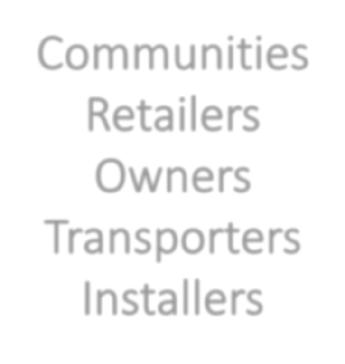
Manufactured Housing Insurance Specialists We’ve got you covered – we insure all segments of the MH industry! Communities Retailers Owners Transporters Installers Be sure to visit us at the 2022 MHI Congress and Expo AmericanInsureanceAlliance.com AIA@AmericanInsuranceAlliance.com
Revisiting John Oliver’s Insulting and Juvenile Take on the Mobile Home Industry
It’s nearing the three-year anniversary since a woke British comic insulted the affordable housing industry with a ridiculous segment that his 20-year-old market demographic took as gospel. In April of 2019, John Oliver’s satire “news” show “Last Week Tonight” declared that everyone in the mobile home industry – including Warren Buffett – were evil capitalists that were taking advantage of the poor. At the time, those who hate capitalism and landlords relished the opportunity to dance around waving John Oliver lunch boxes and declaring their allegiance to the 42-year-old comic and Millennial cult hero. But now, three years later, it really seems so absurd that it might actually be funny.

The origins of the show apparently stemmed from an assistant college professor named Esther Sullivan, who admitted as such in an interview years later with a Denver publication. She gushed that she had been instrumental in the creation of that segment on Oliver’s show. It’s hard to imagine a better authority on woke idiocy than someone who has not even made it to the top of her profession in academia (she’s just an associate professor, after all). Sullivan, of course, was probably trying to peddle her book “Manufactured Insecurity” back then, and I’m sure was blown away that John Oliver would be dumb enough to think her participation might not simply be self-serving. But then again, Oliver appears to put so little effort into his program and fact-checking that he can take all the help he can get.
Of course, Oliver’s position on mobile home parks was about as off-base as he is on almost every other topic on the show since inception. Here are the positions Oliver took in his other segments in 2019 alone:
• The Mueller Report and Trump’s ties to Russia
• Promoting the Green New Deal
• The Necessity to Impeach Donald Trump
By Benjamin Ivry
• Unpleasant Amazon Warehouse Working Conditions
• Condemnation of the American Rifle Association
• Sexism and Racism in Medicine
• Trump’s Ukraine Scandal
• An Interview with Monica Lewinsky
Clearly, woke 20-year-olds have found their leader, but what adult takes any of this seriously?
The list is too long for one paragraph, but the general narrative was that mobile homes are a bad investment for the customer and that making money is evil. The problem is, of course, that nobody buys a mobile home for price appreciation, any more than they think they are buying price appreciation when they buy a car (since both mobile homes and cars are considered “chattel” property and come with a title). Instead consumers are buying mobile homes because they are inexpensive and affordable. When the average single-family home in the U.S. is around $375,000, and the average mobile home is around $35,000, clearly price appreciation is not the customers’ goal here. If you buy a mobile home for $35,000 and a decade later it sells for $25,000 (and assuming that the average apartment rent in the U.S. is around $1,000 per month more than the average mobile home mortgage plus lot rent) the net effect is that you lost $10,000 on the home’s resale, but saved around $120,000 in actual living cost, for a net gain of $110,000. The other issue that Oliver had was that “making money is evil” and decried Frank Rolfe’s devotion to maximizing return on investment targets for investors, a subject that he writes and speaks about regularly, as well as attempting to publicly shame Warren Buffett for being the largest manufacturer and financier of mobile homes in the U.S. Of course, you can’t really argue with the woke set that our country is founded on capitalism and without that system the quality of life would be as low as our socialist and communist counterparts, but certainly any sane adult would take issue with Oliver’s endless mantra on this topic.
John Oliver is a British comedian born in 1977 who started off doing standup comedy in England. His disdain for America is obvious and, although he has developed a following with young Millennials who want to pretend that his show is a newscast, here’s what Oliver’s own Wikipedia page says concerning this incorrect thought: “Oliver’s work has been described as journalism or investigative journalism,
- 16 -
a description Oliver rejects.” In fact, you can tell a lot about Oliver if you simply read his entire Wikipedia page which also notes his political ideologies:
Oliver endorsed Joe Biden for president of the United States and celebrated Biden and Kamala Harris’s victory in the 2020 US presidential election. He warned that “more than 70 million people voted for [Trump] and everything he said and stands for, and that is something we are going to have to reckon with for the foreseeable future.”
In May 2021, Oliver said Israeli airstrikes on civilian buildings in the Gaza Strip “sure seem like a war crime” and added that “Life in Gaza is hard even when they’re not being bombed, and the US government has implicitly co-signed on the brutally hard line Israel’s been taking.”

So, when a woke comedian from England blasts a multibillion-dollar U.S. industry, does the industry fight back? No. It simply turns the other cheek. Why? Because the mobile home sector has an endlessly complacent take on all negative press which has not served it well over the past half-century. We are the Neville Chamberlain of the American housing market, groveling for Hitler to leave us alone rather than fighting back. That’s over now. The MCOAA will no longer allow these media atrocities to go on without counterattack. If anyone wants to write or produce any item that is negative on the industry, it will be met with a swift counter-piece bringing both sides to the conversation and calling out the qualifications of the author.
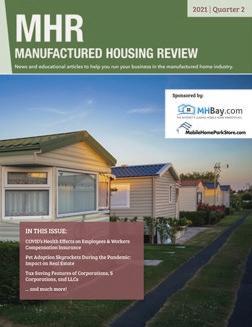
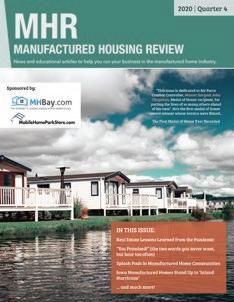
We are very sorry that MCOAA was not around in 2019 to correct the record concerning the pitiful Last Week Tonight episode by woke comic John Oliver. It’s amazing that anyone took this nonsense seriously, yet there needed to be a swift response on record for those few who were misled into thinking this was an actual piece of journalism and not just a comedy entertainment show.
This idiocy has to end, and that starts here.
One of the goals of MCOAA is to take off the gloves and fight back against unscrupulous media attacks. We are devoted to defending the rights and image of community owners nationwide and will never back down from that mission. All community owners must never allow this to go unchecked. We offer the nation’s only form of non-subsidized affordable housing, as well as the only affordable detached housing model in the U.S. Let’s be proud of what we do and not be picked on any longer! We’ll do our part at MCOAA. Join us on that mission.
- 17 -
Revisiting John Oliver’s Insulting and Juvenile Take on the Mobile Home Industry Cont.
SUBSCRIBE! Manufactured Housing Review Magazine www.manufacturedhousingreview.com staff@manufacturedhousingreview.com
Benjamin Ivry has written for The Economist, The Wall Street Journal, Newsweek, Time, The New York Times, Bloomberg.com, and The Washington Post.
Texas Housing Manufacturers Prepare for Sales Surge Despite Ongoing Supply- Chain Disruptions
COLLEGE STATION, Tex. (Texas Real Estate Research Center)
Manufactured housing sales were relatively flat in 2021, but the industry is optimistic about demand and expects Texas activity to accelerate in 2022.
Seven months of production growth have improved the backlog of manufactured homes, according to the latest Texas Manufactured Housing Survey (TMHS).
“The long backlogs that the industry experienced throughout 2021 and the near continuous rise in materials and labor costs limited manufacturers’ ability to take in new orders when delivery times were running in the 40-week range,” said Rob Ripperda, vice president of operations for the Texas Manufactured Housing Association.
“Manufacturers continue to pull those backlogs down through capital investments in their existing plants, bringing new plants online, and expanding their labor force. These measures should open up the order-flow spigots. Housing demand has remained strong, and investors are planning the greenfield development of several new manufacturedhousing communities across the state in 2022.”
 By David Jones and Bryan Pope
By David Jones and Bryan Pope
The TMHS capital expenditure index increased for the 19th consecutive month with additional investment projected on the horizon. The employment index expanded similarly despite skilled- labor shortages that have driven wages and salaries upward. Ongoing supply-chain disruptions continued to contribute to inflationary pressure.
“The sudden surge in cases of the COVID-19 Omicron variant is again dampening optimism about smoothing the supply chain,” said Dr. Harold Hunt, research economist at the Texas Real Estate Research Center at Texas A&M University. “Although less severe than the Delta variant, employers may still see significant employee absenteeism from Omicron in the weeks ahead.”
Despite these headwinds, Texas manufacturers noted less uncertainty and an improved outlook for the first half of 2022.
Funded primarily by Texas real estate licensee fees, the Texas Real Estate Research Center was created by the state legislature to meet the needs of many audiences, including the real estate industry, instructors, researchers, and the public. The Center is part of Mays Business School at Texas A&M University.
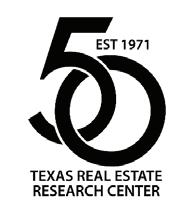
 David Jones d-jones@tamu.edu
Bryan Pope b-pope@tamu.edu
David Jones d-jones@tamu.edu
Bryan Pope b-pope@tamu.edu
979-845-2039
979-845-2088
Thousands of pages of data are available at the Center’s website. News is also available in our twice-weekly electronic newsletter RECON, our Real Estate Red Zone podcast, our daily NewsTalk Texas feed, on Facebook, on Twitter, on LinkedIn, and on Instagram.
- 18 -
Attend Congress & Expo in Orlando in April
After a two-year hiatus, the manufactured housing industry’s largest event is back! Join over 1,200 professionals April 1113 in Orlando for MHI’s 2022 Congress & Expo

Build your business interacting with over 100 Congress & Expo exhibitors and sponsors. Learn about the latest industry trends and innovations through a keynote address and 12 industry workshops. And network with your peers at two evening receptions.


New this year, Congress & Expo will feature The Neighborhood, an outdoor area with three staged manufactured homes on display, provided by Clayton and Skyline Champion. Daily, The Neighborhood will host special activities for attendees, providing fun and interactive ways to network and socialize.
This is your spot for a relaxing outdoor break and the perfect place to catch-up with the folks you have missed or to begin some promising new relationships.
Kick-start your learning experience by registering for the Developer Seminar or National Communities Council Spring Forum on Monday, April 11. Enjoy the Florida sunshine while participating in the Golf Tournament or Clay Shoot on Sunday, April 10, both benefitting MHI-PAC’s Administrative Fund.
MHI’s 2022 Congress & Expo is where manufactured housing industry professionals gather to exchange knowledge, strategies, resources, solutions, and more. Register by April 7th before rates increase. Click here to register.
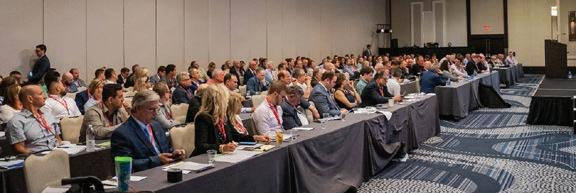
 Ellen Savage Vice President, Member Engagement Manufactured Housing Institute
Ellen Savage Vice President, Member Engagement Manufactured Housing Institute
703.844.0705
esavage@mfghome.org
www.manufacturedhousing.org
- 19 -
Virtual Mobile Home Park Investor's Boot Camp
Learn the mobile home park insider secrets, tricks and shortcuts in a live online 3-day immersion event.
Mobile HomePark Investment Books & Courses

Mobile Home Park Home Study Course
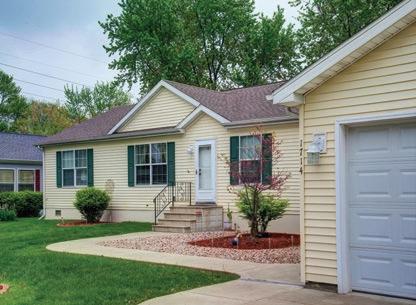
This mobile home park course is hundreds pages and hours of audio. This is not like other real estate courses that just gloss over the subject.
Mobile Home Community Manager Training






The Certified Community Manager Program teaches your Manager how to be a star, and then follows that up with continuing education and support to make sure they play at the top of their game.
The Ultimate Mobile Home Investing & Repair Course
We Will help you to master the entire investment process from start to finish. Knowing the steps is not enough. We also help you to identify the important details and teach you how to avoid the risks associated with mobile home investing and repair!
Mobile Home Park Due Diligence Manual
This manual allows you to find flaws that protect you from overpaying and losing your down payment. It helps point out the drivers to profitability that will allow you to proactively push your returns.
Mobile Home Park Deal Evaluation
Quickly and reliably get the answer to your question: Is this a good deal or not?
MHU.com/LEARN
Investing Outlook for 2022
By D Austin Lewis
Last year, the economy rebounded strongly from the depths of the economic lockdowns of the previous year. Corporate profitability surged as consumers and businesses tried to satisfy pent-up demand. The S&P 500 was up about 28%. Investors had a strong appetite for risk assets.

Things were not so good in the bond market. Investors shed the safety of bonds and fled to the high-flying stock market. The bond market was down about 1.7%.
This disparity in performance between the stock and bond markets was not only about the appetite for risk. Inflation surged, and the Federal Reserve promised to fight inflationary fires by raising interest rates this year. This was not good for
bond prices, as interest rates and bond prices are inversely related.

As for this year, the mood seems subdued. Investors are restless. With pandemic fatigue and anxiety affecting us all, the potential for mistakes is high. Here are the three risks I am monitoring.
1) Inflation
Inflation has surged, and there are two primary causes.
First, there has been a massive disruption in the demand and supply equilibrium.
On the demand side, the demand for many goods dropped off significantly during the economic lockdowns in 2020. Pent-up demand began to build while most of us were stuck at home. This demand was unleashed last year. Corporate profits and stock prices soared.
On the supply side, the opposite occurred. During the economic lockdown, suppliers cut production to match the drop in demand. But as the economic recovery gained momentum, suppliers tried to reverse course, but they could not keep up with demand.
As most of us remember from our basic macroeconomic class, when demand is higher than supply, prices will rise.
- 21 -
Investing Outlook for 2022 Cont.
In addition, the pandemic has been wreaking havoc with the supply chain in hundreds of different ways around the world Workers who had the virus had to stay home from work and isolate, or they decided to quit their jobs, looking for better working conditions and pay. This is causing labor shortages in critical manufacturing and service sectors. Even when goods were successfully produced, it was difficult to get them to market. Ships stacked full of goods could not find a port. Truckers were not available to move the goods that did arrive. Logistics broke down. These things exacerbated supply issues.
2) Rising Interest Rates
The Fed has announced it wants to increase short-term interest rates three times this year. It has also announced that it will be tapering off and terminating its bond-buying program over the next few months. This should help contain inflation.
Second, there has been a massive amount of fiscal and monetary stimulus pumped into the economy to combat the economic downturn caused by the lockdowns. Several relief bills passed during the previous and current administrations injected the economy with additional cash. In addition, the Fed has kept interest rates near zero and has been stimulating the economy with massive bond purchases. As Milton Friedman said, “Inflation is caused by too much money chasing too few goods.”

Even so, many analysts believe inflation will peak soon and subside in the second half of the year. Why? Well, the demand and supply equilibrium is slowly being restored, and supply chain issues have improved. Also, most of the fiscal stimulus has expired. Finally, the Fed has announced that it will be raising short-term interest rates gradually this year and that it is tapering off its bond purchases. Of course, this may also put a lid on economic growth next year. This is all subject to the virus; please read on.

Unfortunately, these moves will also tamp down economic growth, and that makes investors nervous. The year is off to a shaky start. Shares of technology firms have been down over the past several weeks, as these companies tend to rely on low-interest loans to finance growth. And the stock of these companies has been overvalued since the early days of the pandemic. It was a bit of a bubble, and now the air is being released.
Rising interest rates are a double-edged sword. They are unwelcome news for borrowers and economic activity fueled by debt. That said, higher rates are eventually good news for yield-starved investors – like most of us.
3) The Pandemic
The pandemic is the biggest wild card. It has been a thorn in our side for almost two years now. It is unpredictable, to say the least. Last fall, we suffered through the delta wave with the hopes it would be the final wave of the pandemic, but then omicron came along, and cases skyrocketed. Once again, we hope this will be the last wave of the pandemic, but none of us really knows. Another variant could be waiting for us around the corner. Only time will tell.
The pandemic is really the key right now. When cases skyrocket, that exacerbates supply chain issues. It also affects demand. As discussed above, these issues are directly related to the inflation problem.
To understand where inflation and the markets are heading, look at the pandemic. If more variants arrive, inflation will continue to be a major concern, and the markets may react negatively. If the pandemic starts to quiet down, so will inflation and perhaps the markets.
- 22 -
Investing Outlook for 2022 Cont.
All that said, most analysts believe that the bulk of the economic recovery from the lockdowns occurred last year. This year, we should expect more tepid growth. I do not expect another record-setting year.
If you are concerned about the pandemic, stay flexible and disciplined. Rebalance when the market dips and remember that you are a long-term investor. Resist the temptation to try to forecast or time the pandemic. Digest only the best, objective, high-quality financial news, and information. Beware of pundits offering dire financial forecasts. Their agendas are not always aligned with your best interests.
As Jason Zweig of the Wall Street Journal recently said, “The most important asset class this year will be discipline.”
Recommendations
If you are concerned about inflation, consider adding an inflation hedge to your portfolio. Treasury Inflation-Protected Securities (or TIPS) are government bonds that adjust the principal and interest payout to the current rate of inflation. If inflation increases, so does the payout (and vice versa). Other inflation hedges include commodities and gold, but they do not always work. Last year, commodities were up, but gold went down.
If you are concerned about rising interest rates, consider adjusting your bond portfolio. Remember that interest rates and bond prices are inversely related. If interest rates go up, the prices of existing bonds go down. This occurs when the coupon rate of an existing bond is lower than the current rate. That bond is less attractive to investors, and its price goes down.
For this reason, while rates are rising, your bond portfolio should be high in quality and short in duration. These bonds are less sensitive to interest rate adjustments than are longerterm, lower-quality bonds. But keep your eye on new bond issuances to see if new rates become more attractive. You should also be able to get more interest from money market accounts and certificates of deposit, for example.
Finally, on the stock side, make sure to diversify your portfolio to include both value and growth stocks. At the current time, the value stocks are not nearly as overvalued as growth stocks are. Also, higher interest rates are not good for growth companies that rely on low-interest debt to finance growth.
When markets are turbulent and the pressure is on, many investors are compelled to “do something.” This is often a mistake. Make incremental changes to your portfolio. Make sure your portfolio is well designed from the top down, with a good asset class selection and percentage mix. Also, make sure it is sound from the bottom up, with good investment selections for each asset class.
 D. Austin Lewis, President and Founder, Lewis Wealth Management, LLC www.LewisWM.com 855-353-3800 www.LewisWM.com
D. Austin Lewis, President and Founder, Lewis Wealth Management, LLC www.LewisWM.com 855-353-3800 www.LewisWM.com
Austin Lewis is a wealth manager at Lewis Wealth Management, a firm he founded in 2010. He focuses on providing wealth management solutions to a select number of affluent clients in a boutique setting. He is a CERTIFIED FINANCIAL PLANNER professional.
Austin has over 25 years of experience in advising clients as a banker, attorney, and financial advisor. Austin started his career as a business banking officer with Wells Fargo Bank. Upon graduation from law school, Austin practiced law for nine years at two prestigious San Francisco law firms: Gordon & Rees and Craigie, McCarthy & Clow, where he specialized in advising businesses on litigation and transactional matters. When Austin returned home to Colorado in 2001, he served as senior in-house counsel to two Colorado companies: Graphic Packaging and Qwest. Since 2005, he has been advising affluent clients on all their financial matters. Austin received a B.S. in Business Administration from the University of Colorado in 1986, an M.B.A. from San Francisco State University in 1989, and a law degree from Marquette University in 1992. Lewis Wealth Management is a fee-only, investment advisory firm based in Greenwood Village, Colorado. www.LewisWM.com

- 23 -
Titan XTERIOR Prime is a foundation cover built to withstand the demands of everyday life. Our reinforced panel design resists damage caused by lawn care accidents, playful children, and mother nature.
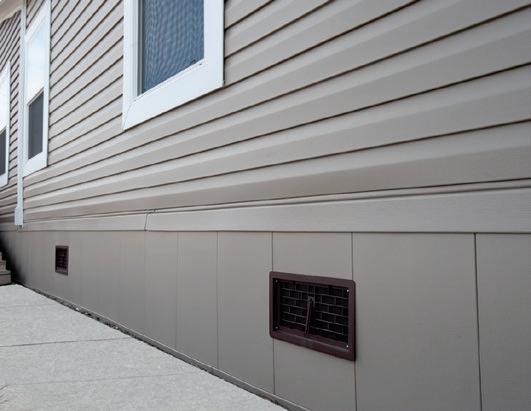

• Offers superior protection from high winds, frost heaving, and hail.
• Covered by a Limited 1-year No Hole Warranty, extended to 5 years upon registration.
• Panel colors include White, Dove, and Clay.
• An insulated panel is also available...
Titan XTERIOR Elite.
www.stylecrestinc.com/titan-xterior | 800.945.4440 Engineered for Strength. Designed for Beauty. Designed specifically for Manufactured Homes.
prime Xterior Titan Foundation Covers | HVAC | Doors & Windows | Steps & Rails | Setup Materials | Vinyl Siding | Plumbing | Electrical
By Benjamin Ivry
Community owners who read the negative news on the industry for the past few years probably noticed that the same name almost always appeared in many of the articles. It was an Assistant Sociology Professor from Boulder, Colorado named Esther Sullivan, who always gave her quoted opinion on the “evils” of mobile home park landlords.
Well, apparently it was not just a coincidence.
Recently, Sullivan was interviewed by the Denver Business Journal where she made a huge admission https:// www.bizjournals.com/denver/c/ special-report-dbjs-2020-40-under40-winners/11749/esther-sullivan. html. In this article she states:
Proudest personal accomplishment in past year: Outside the normal channels of academia, I worked with journalists across the state of Colorado as they produced an innovative collaborative media project on the status of manufactured housing/mobile homes across the state. This is the subject of the last decade of my research, so it was exciting to consult with reporters from The Colorado Sun as they assembled a coalition of a dozen Colorado newsrooms, including newspapers, public radio, TV and digital platforms, to look at what for many is the last form of affordable housing: mobile homes.
Their pieces were picked up by the Associated Press and published in 40+ news outlets across the U.S. This side project made me proud to be a Coloradan. I also assisted with background research in developing a segment on mobile homes for HBO’s “Last Week Tonight with John Oliver.”
So how could an Assistant Sociology Professor in Boulder, Colorado manipulate the media to this extent and without anyone ever pushing back on this perversion of the press?
There are two sides to every story, but the American media today only tells one. And it’s always the one that is against capitalism and landlords. How did the U.S. get this screwed up? It’s odd when a country devoted to capitalism has a media industry focused on publicly shaming that foundation of our country’s origin. How many stories do you read about a tenant who claims that the mobile home park owner never fixed their heater and let them sleep in the cold air when the truth is that the tenant’s heater is working fine but they never paid their
gas bill – or even worse, simply made up the story for their five minutes of fame or possibly a strategy to shake the owner down for money or to scuttle an eviction? Where is the basic concept of “fair and balanced” journalism? It’s long gone in the U.S., unfortunately.
Even though the media has abandoned its principles, why would they give so much power to an assistant professor in Boulder? The answer is simple: the media is absolutely in love with academics. That’s probably because American universities are the incubator for radical ideas delivered in a complete absence of real-life experience and common sense. Sullivan, as far as can be found on the internet, has never owned a rental property, much less a mobile home park. Yet she is somehow an “expert” on a range of issues and the media needs to look no farther than her for meaningful quotes on mobile home parks, the U.S. housing market – the list is endless. Personally, I can think of at least a million people more qualified to discuss these topics than an Assistant Sociology Professor in Boulder.
I guess nobody in media land noticed that Sullivan has been peddling her book titled “Manufactured Insecurity: Mobile Home Parks and Americans’ Tenuous Right to Place“ since 2018 – and you can buy a copy on Amazon for $29 if you like. Here’s one of the reviews of the book that is prominently on the cover “Manufactured Insecurity is a gripping account of the struggles of families losing their marginalized and stigmatized yet cherished mobile homes. Through her insightful analyses Esther Sullivan shows this tragedy is no accident but the result of deliberate neoliberal planning and policy choices in America in the late twentieth century. Manufactured Insecurity is sure to join the pantheon of great books that have forced Americans to take notice of the most vulnerable among us.” -- Lance Freeman, Professor of Urban Planning, Columbia University, and author of A Haven and A Hell: The Ghetto in Black America”. Here is an anti-commerce liberal academic promoting an anti-commerce liberal academic.
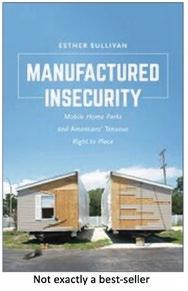
I wonder if there was any personal profit to be made by having 40 publications and John Oliver promoting her book? Did anyone bother to research who she is? On top of that, her current employment, according to her own biography, follows: “I am an Assistant Professor of Sociology at

- 25 -
How an Assistant Professor in Colorado Apparently Caused the Entire Media Uproar Against Mobile Home Park Owners for the Last Several Years
the University of Colorado Denver.” Is an Assistant Professor of Sociology the last person you’d consult as an expert on business and housing stock? Anyone should realize that the goal of an assistant professor is to become a full professor. Is it possible that this media blitz she engineered had the goal of accomplishing that mission?
The really sad part of this story is that nobody ever exposed the Sullivan scandal and how a single Assistant Sociology Professor could pervert the United States media empire to the detriment of a large trillion-dollar industry. Who could have done so? This is the failing of the MH industry for decades now – the apparent lack of engagement in the simple concept of self-defense. The self-enrichment goals of this individual should have been brought to light years ago, and the fact that the media engages in a directed social movement and abandonment of journalism integrity should be a scandal unto itself. Shame on the MH industry for doing nothing to expose this premeditated and unfair attack.
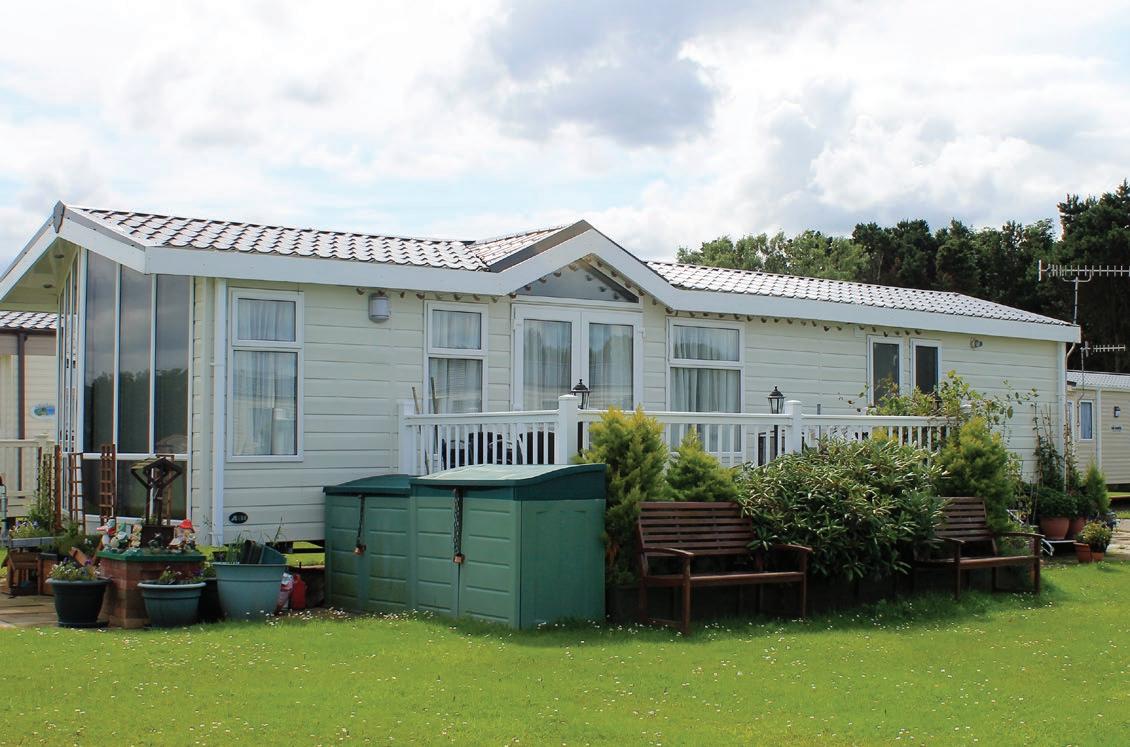
One of the goals of MCOAA is to take off the gloves and fight back against unscrupulous media attacks. We are devoted to defending the rights and image of community owners nationwide and will never back down from that mission. All community owners must never allow this to go unchecked. We offer the nation’s only form of non-subsidized affordable housing, as well as the only affordable detached housing model in the U.S. Let’s be proud of what we do and not be picked on any longer! We’ll do our part at MCOAA. Join us on that mission.

- 26 -
How an Assistant Professor in Colorado Apparently Caused the Entire Media Uproar Cont.
Benjamin Ivry has written for The Economist, The Wall Street Journal, Newsweek, Time, The New York Times, Bloomberg.com, and The Washington Post.
✓ Easy setup
✓ Live chat support
✓ ILS posting for vacant lots

✓ Online applications
✓ Online payments
✓ Online maintenance
✓ Manage lot availability, utilities & charges
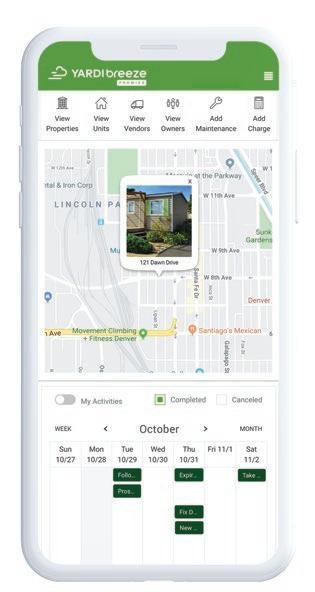
✓ Manage owned or rented homes & RVs

✓ Track home inventory

✓ Vacancy & prospect tracking
✓ Violations management
✓ Email & text communications

✓ Vendor payments
✓ Property accounting
✓ Walk-in payments
✓ Owner payments & reports
✓ Property websites†
✓ Online lease execution†
✓ Utility billing & invoice processing†
✓ Investment management†

YardiBreeze.com | (800) 866-1144 Get a personalized demo to see why Breeze Premier is the perfect tool to run your business from anywhere intuitive & powerful manufactured housing software
All of our needs are met in Breeze Premier,
easier and more cost-efficient.
“
making management
”
you need to manage your communities
Christine Fraser Summit Communities
Everything
*Minimums apply †Additional fees apply Affordable Condo/HOA Self Storage MH
Five Reasons Why Mobile Home Park Investing is Recession and Inflation Resistant
Concerns of an upcoming recession have sparked a renewed interest in commercial real estate investing as a viable alternative to the uncertainties of the stock market and other traditional investment vehicles. However, all real estate investments are not created equal. In fact, mobile home parks have historically delivered outsized returns, even in the worst of economic times. Here are five reasons why investing in mobile home parks is recession and inflation resistant.
1. Mobile home parks generally perform well in both strong and weak economic environments.
According to Green Street Advisors, a global real estate research firm, between 2004 and 2018, operating income from mobile home parks rose by 87%. This income never declined, even during the Great Recession of 2008.
According to Apartment Guide’s annual rent report, rent prices
By Andrew Keel
for a one-bedroom apartment now top $1,600 per month. Contrast that with mobile home park lot rents, that average near $300 per month, and mobile home living becomes a uniquely affordable housing option.
In a strong economy, increases in housing prices, like those we’ve seen over the past two years, make it even harder for low-wage workers to afford housing. In a weak economy, job loss and wage reduction mean that more people need access to affordable housing. Thus, mobile home parks can do well no matter which way the economic wind is blowing.
2. The demand for affordable housing is unprecedented.
Think about the watchwords we’ve seen in the real estate press over the last several years and how mobile home parks can help to eliminate their effects.
• Affordability: Affordable housing has become a primary concern for municipal, state and national governments.
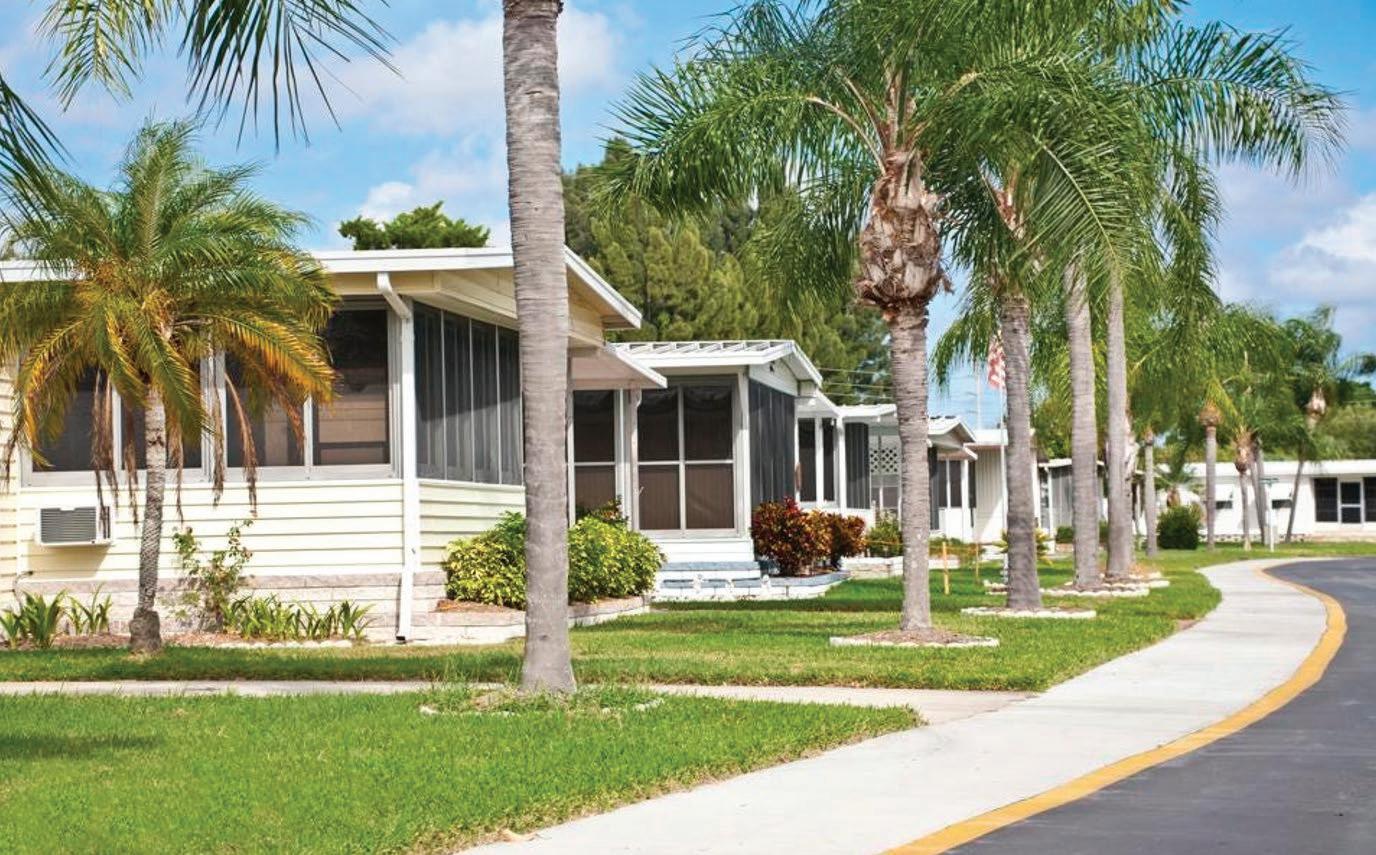
- 28 -
Five Reasons Why Mobile Home Park Investing is Recession and Inflation Resistant Cont.
Mobile homes can be built for less than half the price of site-built housing.
• Low inventory: Unlike single-family homes and apartment complexes, mobile homes can be manufactured in a fraction of the time of fixed construction, allowing them to keep better pace with demand.
• Construction and material shortages: While low home inventory is driven in part by overwhelming demand, it is also affected by a shortage of skilled workers and supply chain interruptions that keep building projects from being completed. These can be circumvented through the faster, more efficient processes associated with mobile home manufacturing. When building a manufactured home, the waste created is typically small enough to fit into one trash can.
3. Mobile home park residents tend to stay put longer.
When mobile home park residents own their own homes, they tend to stay put longer. Over 90% of mobile homes are never moved after they are first installed. This is primarily due to the costs associated with moving the home (approximately $6,000). Also, around one-third of mobile home park residents are retired and not inclined to move as frequently as younger residents. These retired residents add to the economic stability of mobile home park investments with their fixed incomes (Social Security, pensions or SSI), and they typically do not experience disruptions in their income that could cause them to vacate their home.
4. Mobile home parks can operate with higher profit margins.
Because mobile home parks typically operate on high margins (expense ratios around 30%-40%), there is more room to recover in the event of an economic downturn.
As rents rise to keep up with inflation, the principal balance on loans stay the same or are reduced. This means that the lowervalued dollar makes the debt less valuable, at the same time the mobile home park asset itself increases in value.
5.
Given the highly fragmented nature of the asset class (less competition) and the stigma associated, mobile home parks can generally be acquired for higher capitalization rates (net income/purchase price) on the income they produce. Higher cap rates mean better returns for investors.
Is mobile home park investing right for you?
Investing in mobile home parks can be naturally illiquid, so pulling out cash after making an investment is not easy like selling a stock. Also, mobile home parks can be managementintensive; it is important to ensure that you have the right operator behind the scenes with experience managing this type of commercial real estate.
Conclusion
These are the five reasons why I believe mobile home park investing is recession and inflation resistant. Top these with the fact that strict zoning laws make mobile home parks nearly impossible to build today and the asset class starts to shine in comparison to other investment options. Mobile home parks can offer more consistent upside, better long-term profit potential and most importantly: good downside protection. With greater stability, higher margins and lower expenses, mobile home parks offer a uniquely recession- and inflationresistant investment alternative.
Andrew Keel Chief Executive Officer at Keel Team Mobile Home Park Investments, overseeing the company’s acquisitions and investor relations.
Andrew Keel is the owner of Keel Team, LLC, a ‘MHU Top 100’ owner of manufactured housing communities with over 2,000 lots under management. His team currently manages over 30 manufactured housing communities across more than ten states. His expertise is in turning around under-managed manufactured housing communities by utilizing proven systems to maximize the occupancy while reducing operating costs. He specializes in bringing in homes to fill vacant lots, implementing utility bill back programs, and improving overall management and operating efficiencies, all of which significantly boost the asset value and net operating income of the communities. Andrew has been featured on some of the top podcasts in the manufactured housing space, click here to listen to his most recent interviews: https://www.keelteam.com/podcast-links. In order to successfully implement his management strategy Andrew’s team usually moves on location during the first several months of ownership. Find out more about Andrew’s story at AndrewKeel.com

- 29 -
Mobile home parks can be acquired for higher capitalization rates.


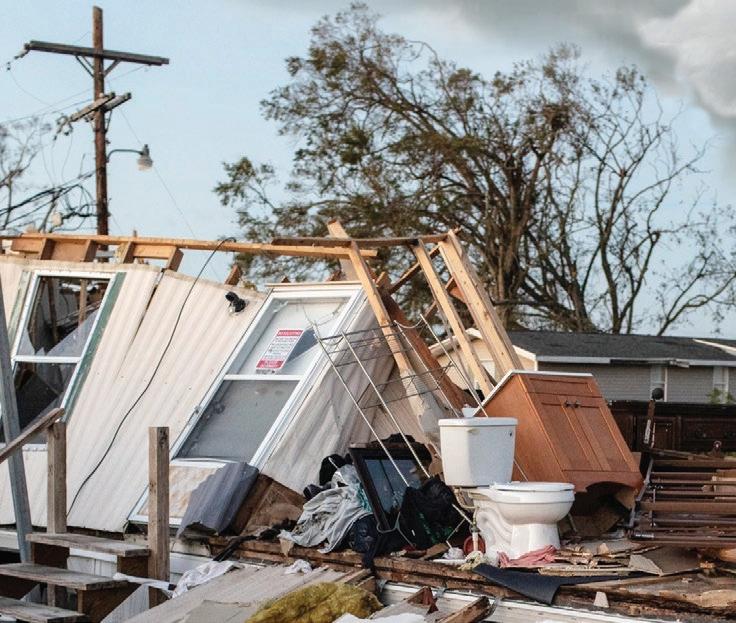
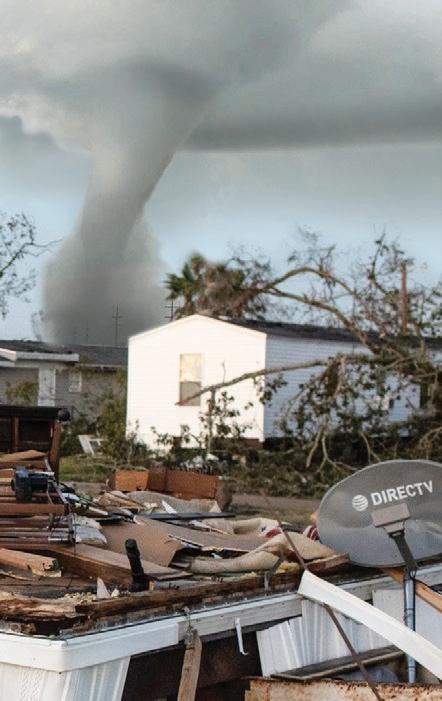






Manufactured Home Retailers Manufactured Home Community Owners INSURANCE MOBILE service@mobileagency.com Call or email today for a free consultation Protecting Your Investments Expert Legal Defense and Protection Special Insurance Programs with Industry Leading Value






Be sure to vi sit us at the Bi loxi Manufactured Housing Show Booth #56 “BRONZE SPONSOR” of the Bi loxiHomeShow.com AmericanInsureanceAlliance.com AIA@AmericanInsuranceAlliance.com We’ve got you covered! We i nsure al l segments of the MH i ndustry! Retailers Communities Owners Transporters Installers Dealers
How to Put Together a Great Loan Package for Lenders That Will Get Approved
Every business, including the business of owning and operating manufactured housing properties requires operators to become skilled in various aspects of a commercial operation to be successful.

These include but are not limited to customer service, marketing, operations, and management. Manufactured housing ownership also uniquely requires the need for operators to understand and ideally excel at property management and in the ability to obtain favorable mortgage financing terms, which adds an entirely new dimension of necessary experience. While the complexity involved can enable manufactured housing owners the opportunity to be creative and add value to their business, it can also be overwhelming at times.
This article aims to help educate and inform manufactured housing owners in one specific but critical business application - how to put together a great loan package for lenders that will not only get approved but also help achieve the best possible mortgage financing terms. No activity during the manufactured housing ownership cycle will impact an owner’s cash-on-cash returns more profoundly than a manufactured housing operator’s mortgage loan terms including their interest rate and their loan’s amortization schedule. In addition, most manufactured housing owners do not realize the wide range of loan terms available in the marketplace. For example, a manufactured housing operator may come to the conclusion that a 25-year amortization schedule offered by local commercial banks is the norm while in reality, 30-year amortization schedules are widely available for “full” loans (even partial or full-term interest only schedules are available for loans less than 70% loan-to-value); you just need to know where to look and which lenders to approach. This is important,
By Gregory J. Porter
as a manufactured housing owner will not only need to obtain a mortgage at the time of property acquisition, but unless the owner obtains a rarely offered long-term, self-amortizing loan (similar to residential home loans), manufactured housing operators will need to refinance their loan balloon 3-5 times during their ownership cycle before the loan is fully paid off. Furthermore, many manufactured housing owners have recognized the benefits of utilizing CMBS loan financing to obtain a “cash-out refinance” mortgage as a unique way to harvest the equity they have created to buy or build additional manufactured housing properties without having to sell their properties and pay capital gains taxes. In that case, the need to refinance their loan balloon every 5 to 10 years continues into perpetuity. The following represents a concise summary on how to best prepare a loan package for lenders.
A professional and effective loan package includes an “offering memorandum” and a description of the property’s annual financial results (or cash flows). Sometimes the offering memorandum includes a table or image of the financial results, other times a separate excel based sizing or underwriting model is prepared and submitted to the loan officer. The offering memorandum provides a loan officer with a narrative description of the property, history of ownership, current business plan, demographic information, competitive market information, a description of the owner/borrower and most importantly, the loan request. The following provides a breakdown of the most important components of an offering memorandum.
Pictures. One of the easiest and most powerful ways to create a loan package that will not only get approved but improve your mortgage loan terms is bright, attractive pictures. Commercial real estate is a business that you can touch and see. The popularity of Instagram, selfies and group photos is a reminder of how powerful the visual medium is. No longer do you need a Nikon camera to take quality photos (although it certainly

- 32 -
How to Put Together a Great Loan Package for Lenders That Will Get Approved Cont.


helps). Most smartphones these days have a powerful lens which with a little practice can showcase your manufactured housing property in the best light. Loan officers rely on pictures since it reflects the condition of your property (i.e., whether your property is attractive and clean or if your property is in need of capital expenditures, which can be indicative of poor property management or in need of better curb appeal). Loan officers also rely on pictures to determine how well your property attracts customers on looks alone, which is one way the lender can forecast your future performance and ability to service your future mortgage (or debt service) payments. The lender will want to see the property’s “frontage” or a picture standing in front of your property which is an image of the first thing your customers see when they step foot on your property. Make sure you take this picture, along with the rest of the pictures, on a sunny day right after your landscaper has cut the grass and everything is tidy and swept. Frame your picture including a flower bed to add colors. If you need examples of how frontage pictures or other pictures look, google some of the REIT owned manufactured housing properties in your city or state and see what photos are posted on google maps to get an idea. In addition to the frontage picture, you will want to take some exterior photos focusing on the most attractive areas of your property. A lot of good photos is helpful but don’t add a bad photo just for the sake of providing a lot of photos. You will also want to have photos of both interiors as well. Pictures of any recent capital improvements is a nice touch and add the applicable notes (i.e., “notice new paving installed in 2020”). Regardless of photos you use, make sure you edit the photo and increase the brightness without going overboard and noticeably eliminating all dark contrast.
After a cover picture, the loan package should describe the physical address of the property as well as a description of the property including the total number of units and occupancy. You will also want to describe the acreage and the amenities the property offers their customers. The loan package should also have the loan proceeds you are seeking, and the associated loan-to-value based on what you think your property is worth. Sometimes owners feel apprehensive to include a “loan ask” when in fact loan officers appreciate having a sense of what you are looking for. In terms of the estimated appraised value you present in your offering memorandum, generally, I would haircut a recent broker opinion of value (or BOV) you
have received by 10% as you do not want to set a hurdle so high that it’s not realistic, however you don’t want to give the impression that your facility is worth less than what a loan officer would assume or present a loan to value so high that the loan officer passes on the loan opportunity. An ownership history narrative description is also important. Describe the year (ideally month and year) that you acquired the property and the purchase price. Describe all of the major capital improvement projects completed with a timeline or schedule. This illustrates to the loan officer that you have made ongoing financial investments to your property to improve its longterm value. Make sure you provide a total cost basis (or your capitalized interest in the facility which would be located as your basis in your tax returns after you add back depreciation) and spend the time to make sure you don’t forget to include any material capital improvements. You should also describe the non-capital ways you have added value (i.e., sweat equity). If needed to kick out and replace problematic tenants that were constantly late or if you increased revenue by adding other forms of revenue, you most certainly want to describe that in the loan package. Describing your business plan along with your tenancy and why tenants rent from your property will provide the lender with the comfort that you understand the business of successfully operating a manufactured housing facility. Lastly, include any strengths you can think of or know of. Keep in mind that a loan officer is focused on term risk or the possibility of default during the term of the loan and balloon risk or the possibility of default at loan maturity. For example, if your turnover rate is below market or your average tenancy has been 10 years even though you have proactively increased rates, you should include this in your loan package. It will provide the lender with an idea of how strong your market is and how loyal your customers are to your business.
- 33 -
How to Put Together a Great Loan Package for Lenders That Will Get Approved Cont.
Whether you are seeking financing terms from a local lender that understands your immediate market well or from a national life insurance or Wall Street CMBS lender which provides 10-year fixed rate non-recourse mortgages but may not know your market, you will want to describe the demographics and demand drivers for your property. This includes important items like median household income, population growth, current population and population growth along with the percentage of renter’s vs owners. www.city-data.com is a free website that provides all the information you need with no need to register; you just need to enter your property’s zip code followed by “citydata. com” in google to find your zip code demographics in the first search result. Furthermore, it is important to describe the top employers in your town, city or county. Googling “top employers in <enter county or city name>” should likely provide you with a local news article or the website of your chamber of commerce that will provide you with this information. You may also know of the major employers in your area or that of many of your customers. Also, describing any new developments (i.e., newly built hospital 3.2 miles north of your facility or a new townhome development 1.6 miles south) will help the lender understand the current commercial real estate and economic activity. Google maps also provides distances from your property to new major employers or developments which will give the lender a feel for the surrounding area and speed up the analysis that he or she will need to complete to better understand your property and the local market. As previously mentioned, make sure you describe your customers and any significant demand generators (i.e., students, military personnel, etc.).
You will also want to describe your competitive market and how your manufactured housing facility competes within its competitive submarket. You will also want to describe your rent levels relative to market, particularly if there is upside in revenue (or minimal downside in rents if a new competitor enters the market). Lastly, if you know of any new manufactured housing properties coming online (in planning or actively in development), you will want to disclose that to your lender and mitigate the risk i.e., market can easily absorb additional units as the competitive market is 95% occupied.
Lastly, you will need to provide a description of the ownership and sponsorship information. The description of the ownership should include a full breakdown of every individual that has an ownership interest, their respective interests and identify the managing members (presumably you and possibly others). You will want to provide a resume focused on your commercial real estate ownership and management experience
describing the number of manufactured housing properties you own and manage, the city and states (if applicable), and total number of units. You will want to describe the years of experience and specify if you have experience in “turnaround or value-add” projects, construction development experience, and affiliation with manufactured housing organizations. Your financial wherewithal is important for lenders to consider your proposal, but an approximate net worth and your approximate liquidity is enough information. Remember the old adage, “under promise and over deliver”. Be conservative if you are giving estimates. As a rule of thumb, most lenders ideally want sponsors whose net worth equals the loan amount and liquidity that equals 10% of the loan amount. If there are multiple managing members in the sponsorship, you can provide collective net worth and liquidity. If the managing members are collectively shy of meeting these requirements, you may need to ask one of your limited partners to provide their financial information and check their interest in potentially signing either a recourse loan guaranty or a non-recourse “bad boy” guaranty depending on the loan you are seeking. The other option is you can hire an experienced mortgage broker professional that can identify the types of loans and lenders that will be more accommodating.
Finally, if you have any credit blemishes including but not limited to foreclosures, deed in lieus, bankruptcies, significant litigation, or litigation against a financial institution, you will want to disclose this to your loan officer BUT also describe the applicable mitigants or circumstances. The last thing you want to do is hope it doesn’t come up and not describe credit issues. The lenders will more than likely find more than you think and your credibility with your lender is the most important commodity you have to offer. Finally, a low credit or FICO score are important to local commercial lenders, and

- 34 -
How to Put Together
a
Great Loan Package for Lenders That Will Get Approved Cont.

you will want to describe the circumstances relating to the low score.

Along with a narrative offering memorandum, you will ideally want to include an excel based “sizing” or underwriting cash flow includes historical (i.e., multiple years) of financial performance, your next year budget, and an “underwritten cash flow”. An underwritten cash flow represents a lender’s annual estimate of your facility’s next year’s financial performance while meeting relatively standardized underwriting lending requirements like (i) a minimum vacancy allowance, which is the greater of the actual vacancy, the submarket vacancy and 5%. An underwritten cash flow also includes a 5% property management fee whether you pay a third-party company or yourself or not. The underwritten expenses are a line-by-line estimate and generally represent the highest year’s expense during the last three years (unless there is a legitimate explanation to use a lower figure). An underwritten cash flow includes a replacement reserve deduction to account for ongoing capital expenditures which are generally be $50 per manufactured housing unit. Lastly, you should include cash flow notes, which explains year over year variations like a decrease in a specific line item or a sharp increase and
what your underwritten revenue and expense line items were based on. If providing an underwritten cash flow beyond your current capabilities, you can simply provide 3 years of historical operating statements along with a current rent roll along with the offering memorandum and you should be on your way to improving the quality of your mortgage loan terms.
Gregory J. Porter previously worked as a senior commercial real estate loan underwriter and as the chief underwriter approving loans on manufactured housing properties located nationwide for over 20 years, including as a senior underwriter at Deutsche Bank for seven years, as a senior underwriter at JPMorgan, and as the former Chief Underwriter of Barclays, PLC with a $100.0 million signature authority. Throughout his career, Gregory has approved or originated over $800.0 million of manufactured housing mortgages. Gregory attended New York University’s Stern School of Business where he graduated with a BS in Finance and International Business, was awarded one of “20 Rising Stars of Real Estate” by Institutional Investors News (2007) and is a regular contributor to Inside Manufactured Housing Magazine and CCIM’s CIRE Magazine.
- 35 -
REGISTER TODAY!
Don’t miss out on three days of:
w Educational sessions taught by industry experts and leaders in the field
w Networking opportunities with over 1,200 attendees
w 140+ exhibit booths and companies to explore
w High-level mainstage speakers
ADDITIONAL CONGRESS & EXPO
Monday, April 11
EVENTS
w Developing with Manufactured Housing Seminar*


w National Communities Council (NCC) Spring Forum*
THE NEIGHBORHOOD NEW THIS YEAR!
w The Neighborhood is an outdoor area that will feature staged manufactured homes, outdoor seating, games, and daily activities
w Each day there will be special events for attendees providing a fun and interactive way to catch-up with industry peers
BECOME AN EXHIBITOR
w Limited spots remain
w Booths start at $799
ADVANCE MHI’S ADVOCACY
Proceeds go to the MHI PAC Administrative Fund. Sunday, April 10
w 4th Hart Kienle Pentecost and Lutz, Bobo & Telfair Clay Shoot
w 16th Annual Oliver Technologies Golf Open
For details and a complete schedule visit CongressAndExpo.com. #MHIcongress I registration@mfghome.org
* These seminars are an additional fee and require a full Congress & Expo registration.

REGISTER IN ADVANCE Rates
April 8
Increase
April 11-13, 2022 Rosen Shingle Creek | Orlando, FL
58% IRR: A Mobile Home Park Opportunity Zone Case Study
By Daniel Weisfield
We acquired our Meadowlands Estates Opportunity Zone manufactured housing community for $2,800,000 in 2019, and we just refinanced at a $6,350,000 valuation. If we sold today, we would generate a 58% IRR (before tax benefits).

We did a ton of heavy lifting to create value for our Investors on this deal while also creating a vibrant new affordable neighborhood for our Residents. I’m deeply proud of our team’s work on this deal, and I want to share it as a case study.
Sourcing the opportunity
Totally off-market. We sourced this deal “boots on the ground.” No brokers involved. Yoel and I closed the deal over dinner with the Glaspey family in Yakima, WA. The Glaspeys were pioneers in the Yakima Valley. Their family had owned this land for over a hundred years.
Yakima is the kind of under-rated tertiary market that Three Pillar Communities loves to invest in: strong housing demand driven by non-cyclical industries, with little new housing supply, and not too many investors fighting for deals and driving
prices up. Economic growth in Yakima is driven by agriculture (especially apples and hops), specialty manufacturing (e.g., aerospace, plastics), and education and healthcare, which real estate investors refer to as “eds and meds” because they are such an important economic engine (Yakima has 3 hospitals, 4 colleges, and a new medical school). Yakima’s apartment vacancy rate was below 2% when we were analyzing the deal in 2019.
And the icing on the cake...Meadowlands is located in a federally designated Opportunity Zone, conferring major tax benefits to our investors. More on that later.
The opportunity we saw
We saw a rare “blank canvas” where we could create a contemporary manufactured housing community in a strong tertiary market with high housing demand.
The Glaspeys had built the park infrastructure in the 1990s (for 78 units), but had only brought in 25 homes. We were confident that the high vacancy at Meadowlands was due to the prior owner’s management choices and financial constraints, and not due to lack of market demand.
- 37 -
and Yoel Kelman
58% IRR: A Mobile Home Park Opportunity Zone Case Study Cont.
We saw a rare opportunity to meet the investment requirements for a Qualified Opportunity Fund, which would add rocket fuel to our investors’ after-tax returns.
We knew we would have to fill 53 vacant lots with new homes. Fortunately, we had built the capability to do this work in-house. We are licensed manufactured home dealers in six states, we have multiple credit lines for this purpose, and we have multiple team members working on manufactured home procurement, installation, and sales.
We knew we wanted to sell all of our new manufactured homes to the end customers, rather than renting them out as “park owned homes.” Selling homes is a lot harder than renting homes, and has a slower sales cycle, but it results in affordable homeownership and ensures lower tenant turnover in the long run.
The structure of the buy
$2,800,000 purchase price
We negotiated seller-carried financing for a $2,050,000 loan (73% of the purchase price), at an attractive rate, with interest only payments, for up to 3 years.
In exchange for the Glaspeys giving us seller-carried financing, we agreed to cap rent increases for certain residents (whose rents were 50% below market) as long as the seller-carried loan was in place.
The heavy lift – AKA how we turned an old cow pasture into a vibrant new affordable neighborhood
Refining the home spec to meet the market. We experimented with single-wides and double-wides, big floor plans and small floor plans, fancy kitchens and utilitarian kitchens. By listening to customers we identified the optimal spec for this community: a 1500 square foot home, 3 bed/2 bath, with a few “wow” features in the kitchen (like pendant lights and a farmhouse sink), and a basic finish level in the rest of the home.
Experimenting with different sales models. We first tried listing the manufactured homes with a local realtor. We hired a bilingual sales lead and experimented with Spanishlanguage advertising. We did direct outreach to local realtors to educate them about manufactured homes and offer bonus commissions. Through testing and iterating, we finally developed a smooth, repeatable sales model.
Dialing in a process with our set-up contractor. While we originally planned to work with multiple set-up crews to ensure enough sale-ready inventory, we eventually dialed in a great process with a single contractor partner, to the point where construction became “plug and play.” Huge shout-out to Glen and Loren for rocking our home set-ups!
Performing infrastructure upgrades in-house. We realized that Glen and Loren were highly efficient at setting homes on “prepped” lots, but they were constantly getting bottlenecked by underground infrastructure issues. They would have to search for utility hookups, and if they couldn’t find them, they’d have to stop work, fire up the excavator, and spend a day digging trenches to extend water and sewer lines from the to the home site. To solve this once and for all, we sent one of our employees (who is an expert heavy equipment operator) to Meadowlands for a month to knock out all the underground utility extensions at once. We got the work done at a fraction of the cost of paying a contractor, and it enabled Loren and Glen to hit a timely, predictable home set-up cadence.
Finally achieving the “flywheel effect.” Our first ten home sales were an uphill battle. Customers hadn’t heard of Meadowlands, and they weren’t familiar with our product (i.e. new manufactured homes in a land-lease community). The next ten home sales got easier. And then, at a certain point... the homes started selling themselves. Word got out about the quality of our community, happy residents told their friends, and suddenly we were fielding inbound leads.
Raising our home sale price in response to rising input costs. During COVID, our cost to procure manufactured homes went up around 30% due to labor shortages and supply chain disruptions. We raised our sale prices accordingly, and fortunately we have had no problem selling our homes in the $140k range. This is due to 1) sales momentum for this community, based on happy customers telling their friends, and 2) overall strength in the housing market. With housing prices up across the board, manufactured homes remain one of the best values in the market.
The refi: Monetizing the value we created
We refinanced Meadowlands in December 2021 at a $6,350,000 valuation, returning capital to our investors. At the time of the refi we were 73% occupied.
We were thrilled to lock in five years of interest-only debt at
- 38 -
58% IRR:
A Mobile Home Park Opportunity Zone Case Study Cont.
3.25% (fixed rate), with a flexible prepayment structure.
The additional homes needed to achieve 100% occupancy are all in the pipeline, and we plan to achieve 100% occupancy by year-end 2022.
By refinancing the Glaspeys’ seller-carried loan, we retired the rent increase covenants that we had agreed to maintain as long as the loan was in place. We have now raised rents for “legacy tenants” from $281 per month to $475 per month. This rent increase was crucial. Charging market rents is necessary to ensure the viability of our industry and to ensure that more manufactured housing investors can build new affordable neighborhoods, like we have done at Meadowlands. Our new $475 rents are still extremely affordable for working families, using any affordability metrics you might care to use. And as we expected, we have had zero resident move-outs and strong ongoing demand.
The social impact we created
Increasing the supply of affordable housing: By year-end 2022, we will have created 53 new units of affordable housing in a market that sorely needs it.
Creating a vibrant new affordable community: We have essentially created a brand-new neighborhood. Neighbors help their neighbors. Kids ride bikes in the streets. Everyone is a homeowner and is invested in the community. Research shows that when lower-income people have housing stability, community, and connection, there is a direct positive impact on health, wealth, and educational outcomes.
Closing the racial wealth gap: In Yakima, many of our new homebuyers are either Hispanic (Latinos now make up more than half of Yakima County’s population) or members of the Yakama Tribal Nation. We are proud to be helping historically under-represented homebuyers build wealth through homeownership.
Fighting climate change through efficient factory-built housing: Our homes are built efficiently, in a central factory location, with minimal material waste. We use R-22 insulation and low-E double-pane windows. Thirty-year shingles and “never fade” siding ensure that our homes will last for decades, reducing waste from replacement.
Opportunity Zone tax benefits – and estimated returns for our investors
If we sold Meadowlands today (at our $6,350,000 appraised value) we would achieve a 58% gross IRR. Not bad.
However, if we sold today, our investors would have to pay taxes on their capital gain.
This is where the magic of the Opportunity Zone investment comes into play. If we hold Meadowlands for at least ten years (which we plan to do anyways – because we have a multidecade investment strategy), qualified investors will owe zero capital gains tax upon sale. Additionally, on the front end, our investors already deferred and reduced the tax they would have owed on the capital gains which they invested into the Meadowlands deal.
In aggregate, we projected that our Opportunity Fund investors could boost their returns by as much as 19% through the tax savings provided by the Qualified Opportunity Zone.
For more detail on how the Opportunity Zone tax treatment works, check out this quick overview we put together in 2019: Meadowlands Opportunity Zone - Summary of Tax Benefits
In conclusion
This deal has been a grand slam both for our Residents and for our Investors. We have multiple deals like this in our pipeline, and we look forward to replicating this manufactured housing playbook in other locations.
Daniel Weisfield (Co-founder) is a third-generation mobile home park investor. His grandfather immigrated to the United States, saved money by fixing cars in his backyard, and eventually bought a mobile home park. Daniel is a licensed manufactured home dealer in four states and believes manufactured housing is the best way to create affordable communities that residents are proud to call home. Daniel has a J.D. and M.B.A from Yale. He previously worked as a management consultant at McKinsey & Company. daniel@threepillarcommunities.com
Yoel Kelman (Co-founder) is a manufactured housing finance and operations expert. His grandfather immigrated to the United States, worked as a butcher, and eventually bought single-family home rentals. Yoel holds an MBA from MIT and is a CPA. Prior to co-founding Three Pillar Communities, Yoel co-founded EcoVent, an energy technology company. Yoel@threepillarcommunities.com


- 39 -
Three Pillar Communities

MHR MANUFACTURED HOUSING REVIEW We are an electronically delivered quarterly magazine focused on the Manufactured Housing Industry. From Manufactured Home Community Managers, to Retailers, to Manufacturers, and all those that supply and service them, we supply news and educational articles that help them run their businesses. ManufacturedHousingReview.com Communications regarding any alleged offending, inappropriate, inaccurate or infringing content should be directed immediately to kkelley@manufacturedhousingreview.com along with the communicator’s contact information. Have something to contribute or advertise? Email us at staff@manufacturedhousingreview.com





































 By David Jones and Bryan Pope
By David Jones and Bryan Pope

 David Jones d-jones@tamu.edu
Bryan Pope b-pope@tamu.edu
David Jones d-jones@tamu.edu
Bryan Pope b-pope@tamu.edu




 Ellen Savage Vice President, Member Engagement Manufactured Housing Institute
Ellen Savage Vice President, Member Engagement Manufactured Housing Institute








 D. Austin Lewis, President and Founder, Lewis Wealth Management, LLC www.LewisWM.com 855-353-3800 www.LewisWM.com
D. Austin Lewis, President and Founder, Lewis Wealth Management, LLC www.LewisWM.com 855-353-3800 www.LewisWM.com







































